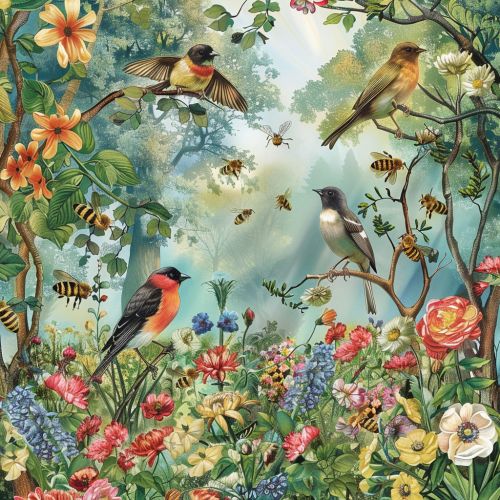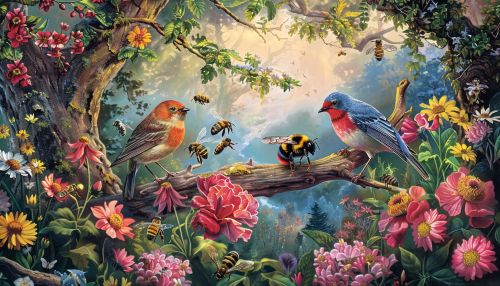The Birds, The Bees & The Monkees
Introduction
"The Birds, The Bees & The Monkees" is a multifaceted topic that intertwines the natural world of avian and insect reproductive behaviors with the cultural phenomenon of the 1960s pop band, The Monkees. This article delves into the biological intricacies of bird and bee reproduction, explores the cultural impact of The Monkees, and examines how these seemingly disparate topics intersect in popular culture and scientific discourse.
Avian Reproductive Behaviors
Mating Systems
Birds exhibit a variety of mating systems, including monogamy, polygamy, and promiscuity. Monogamy is the most common, with approximately 90% of bird species forming long-term pair bonds. Polygamous systems, such as polygyny and polyandry, are less common but occur in species like the Red-winged Blackbird (polygyny) and the Northern Jacana (polyandry).
Courtship Rituals
Courtship rituals in birds are complex and varied. These behaviors often include vocalizations, displays of plumage, and intricate dances. For example, the Birds of Paradise are renowned for their elaborate courtship displays, which involve intricate dances and striking plumage presentations to attract mates.
Nesting and Parental Care
Nesting behaviors and parental care strategies are diverse among bird species. Many birds, such as the American Robins, build nests in trees or shrubs, while others, like the Common Murres, lay eggs on bare rock ledges. Parental care can range from biparental care, where both parents share responsibilities, to uniparental care, where only one parent is involved.
Apian Reproductive Behaviors
Colony Structure
Bees, particularly honeybees, exhibit a highly structured colony system. The colony consists of a single queen, numerous workers, and a few drones. The queen is the sole reproductive female, while workers are sterile females responsible for foraging, brood care, and colony maintenance.
Mating Flights
The queen bee engages in a mating flight, during which she mates with multiple drones in mid-air. This process, known as polyandry, ensures genetic diversity within the colony. After mating, the queen stores the sperm in her spermatheca and uses it to fertilize eggs throughout her life.
Brood Rearing
Worker bees are responsible for brood rearing, which involves feeding larvae with royal jelly, pollen, and honey. The type of food provided determines whether a larva will develop into a worker, drone, or queen. Royal jelly, a protein-rich secretion, is fed exclusively to larvae destined to become queens.
The Monkees: Cultural Impact
Formation and Rise to Fame
The Monkees were formed in 1965 for a television series of the same name. The band consisted of Micky Dolenz, Michael Nesmith, Peter Tork, and Davy Jones. Initially, the members were selected for their acting abilities rather than musical talents. Despite this, they quickly rose to fame, producing several hit songs and albums.
Musical Contributions
The Monkees' music, characterized by its catchy melodies and harmonious vocals, left a lasting impact on the pop and rock genres. Songs like "I'm a Believer" and "Last Train to Clarksville" became chart-toppers and remain popular today. The band's ability to blend pop, rock, and folk elements contributed to their widespread appeal.
Legacy and Influence
The Monkees' influence extends beyond their music. They played a significant role in the development of music videos and paved the way for future television bands. Their innovative approach to combining television and music set a precedent for later acts like The Partridge Family and Hannah Montana.
Intersection in Popular Culture
Symbolism and Metaphor
The phrase "The Birds and the Bees" is a common euphemism for explaining human reproduction and sexual education. This metaphorical use of avian and apian behaviors highlights the natural world's role in understanding human sexuality. The Monkees, with their playful and often irreverent approach to music and television, have occasionally been referenced in discussions about cultural depictions of sexuality and relationships.
Educational Media
Both avian and apian reproductive behaviors and The Monkees have been subjects of educational media. Documentaries and educational programs often use birds and bees to explain biological concepts, while The Monkees' television series and music have been analyzed in media studies courses for their impact on popular culture and television history.


See Also
- Bird Reproduction
- Honeybee Colony Structure
- 1960s Pop Bands
- Courtship in Animals
- Television and Music Integration
